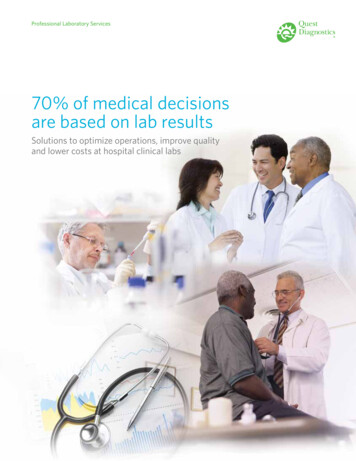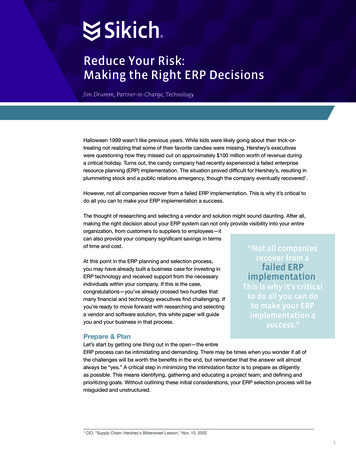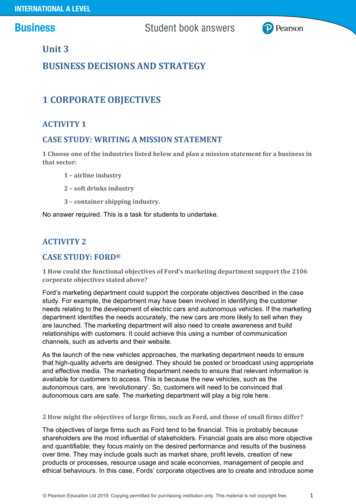
Transcription
Professional Laboratory Services70% of medical decisionsare based on lab resultsSolutions to optimize operations, improve qualityand lower costs at hospital clinical labs
Framing the IssueHealth care in the United Statesincludes a vast array of complexinterrelationships among thosewho receive, provide andfinance care.U.S. health care employs 13% of the workforce and hasexpenditures of approximately 3 trillion or 18% of grossdomestic product (GDP).1,2Due to the economic challenges,the rising cost of health care is amajor issue for patients, employers,providers and payers. The desireto reduce cost and increase qualityis forcing health care to move froma fee-for-service to value-basedoutcome model, where paymentswill be constrained and subjectedto increased transparency. Theculmination of all these changes ishaving an adverse impact on thebottom line of many hospitals andhealth systems across the country.Given the pressure resulting fromdeclining reimbursements, reducing2costs and eliminating redundanciesare the top priorities for hospitals andhealth systems. Within the hospital,clinical labs are being impacted ontwo fronts. On the inpatient side,Medicare payment pressures areforcing labs to cut expenses. Onthe outpatient side, clinical labs areconfronting fee schedule reductions,a new bundled payment systemand uncertainty about Medicarereimbursement rates. 3Laboratory testing plays a crucialrole in the detection, diagnosis andtreatment of disease in patients.An estimated 70% of all decisionsregarding a patient’s diagnosis andtreatment, hospital admission anddischarge are based on laboratorytest results. As health care reformfocuses on diagnosis and earlyintervention, timely and accurate labresults are necessary for the qualityof patient care and for managingdownstream costs.Therefore, ongoing investment inthe hospital laboratory is crucialas it allows:1. Quality of testing2. Operational efficiencies3. Access to the latestdiagnostics testingand services4. Patient safetyIn order to demonstrate value fromtheir labs, and remain profitable,hospitals are partnering withnational clinical laboratories whichcan drive operational efficienciesand cost savings. Nationallaboratories like Quest Diagnosticsoffer solutions ranging fromreducing costs through laboratorymanagement to enabling deeperclinical capabilities through analysisand management of test utilization.
Reducing Costs Through Hospital Laboratory ManagementTable 1: H ow hospitals can benefit from working with nationalclinical laboratoriesAlthough some larger systemshave modernized their laboratoryoperations and built centralizedcore-labs, the majority ofhospitals and hospital systemsnationwide are still not operatingat optimum capacity and output.Quest Diagnostics offers hospitalslaboratory management solutionsthat are designed to lower cost,reduce capital investment, improveoperational efficiencies and deliverquality patient care and service(Table 1).Today, hospitals spend on average3-4% of their net patient revenueon clinical laboratory services.For mid-size 300-500 bed hospitalswith annual net patient revenueof approximately 300 million,contracting with a national diagnostictesting laboratory could reduce thelaboratory spend up to 20% or 2million annually (Figure 1). However,as the scale and scope of theoperation increases, as in the caseof larger hospital systems, greatersavings could be realized annually.ProblemSolutionHigh costs due to limitedpurchasing scale economiesand fluctuating testing volumesCost reduction by benefiting fromlarge purchasing scale economiesand moving testing from a variablecost to fixed costPeriodic investment neededfor latest equipment upkeepand purchasesPurchasing of laboratory equipmentmanaged by Quest Diagnostics,thereby providing hospital withaccess to the most sophisticatedand latest testing capabilities.This also liberates capital whichcan be invested elsewhereSubpar operationalefficiencies due to lack ofstandardized processesImproved laboratory operationalefficiencies, such as reducing lab realestate footprint thereby reclaimingvaluable space which can beallocated elsewhereLimited quality trackingand improvement metricsAdvanced quality measurement,analysis and tracking metrics throughimplementation of clinical lab bestpractices at the hospital labStaffing shortages of skilledtechnicians, phlebotomistsand medical directorsLab employees managed andemployed by Quest DiagnosticsInability to effectively andaccurately report due to fragmentedand uncoordinated IT systemsAccess to advanced connectivitysolutions and data drivendiagnostic insightsFigure 1: Cost savings through laboratory managementCost savings for a typical 400 bed hospitalEquipment 10M 2MSupply cost 8MHow will this be realized? Leverage purchasing economiesEliminate future CapEx Reduce administrative support costs Optimize site testing locationUp to 20%overall costsavingsLaborBeforeFree up physical spaceIncrease productivityAfter70% of medical decisions are based on lab results3
Eliminating Redundancies Through Network OptimizationThe last few years have seen anincrease in the number of mergersand acquisitions of hospitals andhospital systems. High levels ofconsolidation activity are likely tocontinue, driven by the need tointegrate clinically, manage costs andprepare for the shift from volumeto value-based reimbursement.4However, when hospitals consolidatethey introduce redundancies andsubpar operational efficiencies dueto lack of standardized processes. Byworking with national laboratoriessuch as Quest Diagnostics to manageand optimize their lab testing network,hospital systems can address theseredundancies, reduce costs andcontinue to deliver high quality patientcare, as shown in Table 2.Table 2: How hospitals can benefit by optimizing laboratory operationsProblemBenefit from a Clinical Lab PartnerMultiple testing sites onsolidation of testing sites based on key business factors such as logisticalCcomplexity, potential savings, turnaround times, purchasing costs and ease ofimplementationFrees up valuable real estate which can be used elsewhereDuplicated servicesOptimization of operations ensures streamlining and eliminates duplication ofservicesSubpar test volumesConsolidation allows for testing volume to be driven to fewer hospital labsAd hoc test menuStandardized and latest test menu available throughout the hospital network,thus allowing better, more effective coordination of patient careQuality and service issuesBest practice sharing and introduction of advanced quality metricsmeasurement, analysis and trackingLeaner workflow and automation can result in quicker test result turnaroundtime which can reduce length of stay and improve physician and patientsatisfaction4
Generating Revenue Through Laboratory OutreachThe past decade has seen steady growth in the numberof hospital laboratory outreach programs servingoffice-based physicians in surrounding communities.Under these outreach programs, hospitals utilize excesslab capacity and generate revenue by providing testingservices to community physicians.Outreach partnership programs typically constitute:Large national laboratories, such as Quest Diagnostics,can help hospital outreach programs achieve a competitiveadvantage by helping them understand the diseasecharacteristics of the market, help coordinate care ofdesired outcomes and ensure compliance with guidelines.4. Physician Office IT Connectivity1. Analysis of market data to providediagnostic insights 2. Hospital Laboratory Workflow Assessment3. Phlebotomy Services5. LogisticsAdditionally, a laboratory management arrangement, whichis designed to improve efficiencies and reduce lab costs,could generate a better margin on outreach services.Reducing Hospital Acquired InfectionsIn a report, “Antibiotic ResistanceThreats in the United States, 2013”,the CDC highlights that at least2 million people become infectedeach year with antibiotic-resistantbacteria, and at least 23,000 peopledie annually as a direct result ofthese infections, which increasehospitalizations and extendedhospital stays, adding considerableand avoidable costs to the healthcare system.In an effort to reduce these costs,hospitals no longer receive additionalpayment for cases in which certainconditions were not present onadmission. Also, beginning 2015,hospitals scoring in the bottomquartile for the rate of hospitalacquired conditions (i.e., those withthe poorest performance) will havetheir Medicare inpatient paymentsreduced an additional one percent5,6To mitigate the financial risk introducedby hospital acquired conditions,health care leaders are turning tonational clinical laboratories suchas Quest Diagnostics that offersolutions ranging from inbound patientscreening to empirical treatment ofmultidrug resistant organisms.Surveillance testing which is performed at admission allowshospitals to screen inbound patients for infections present onadmission and helps early detection of multidrug-resistantorganisms (MDROs).FeaturesBenefits arly detection and identificationEof infections 1. Helps hospitals control theirinfection levels arly detection of colonizationEwith MDROs2. Improves patient care outcomes recautionary isolation andPtreatment of patients3. Helps prevent other patients frombeing infected4. Allows hospitals to maintainreputation within the communityAntimicrobial susceptibility testing, a program aimed at reducinghospital acquired infections is performed during diagnosis andtreatment of hospital patients and enables specific treatment ofmultidrug-resistant organisms.FeaturesBenefits Provides institution-specificantibiogram reports ids in the empirical treatmentAof infections1. Helps reduce hospitalacquired infections causedby resistant organisms Monitors antimicrobial resistance2. Allows hospitals to avoidlonger inpatient staysand/or readmissions3. Lower the cost of patient careand financial burden to hospitals4. Helps reduce the cost ofantimicrobial therapy70% of medical decisions are based on lab results5
Analyzing and Managing Test UtilizationNational clinical laboratories like Quest Diagnosticsare offering hospitals solutions such as test utilizationanalysis and the ability to identify at-risk patients forearly and appropriate intervention, as part of populationhealth management.Data mining and diagnostic insights are at the heart ofa successful utilization management program, whichtypically constitutes:1. Data extraction from LIS2. Data stratification & analysis to determineutilization patternsAs Medicare and other payers increasingly targetoverutilization as a way to curb costs, the evaluation ofthe medical necessity, appropriateness and efficiency ofthe use of health care services has entered the realm oflaboratory testing.3. Guideline driven education & monitoringof testing algorithms & reflex testing4. Migrating to best practices and implementingcontinuous improvement and reporting initiatives15%12%9%6%3%0%19881990 1992 1994 1996 19982000200220042006200820102012 20132000200220042006200820102012 2013Figure 3: Test utilization analysis and management solutions from Quest otein ApolipoproteinApolipoproteinApolipoprotein ApolipoproteinApolipoprotein etaminesFor ol2009MethaqualoneDoes the patienthave clinicalASCVD?bOxidizing MarijuanaSubstitutedModerateintensity therapydYesHigh-intensitytherapyc,dNo10-y ASCVDrisk 7.5%eHigh-intensitytherapyd10-y ASCVDrisk 7.5%eModerate- to highintensity therapydModerate-intensitytherapyd2011Clinical guideline driventest utilization analysisRisk Stratification Overutilization of testing Acute conditions Test utilization stratified by age Underutilization of testing Chronic conditions est utilization stratifiedTby site In range testing est utilization stratifiedTby timeAge 75 yAge 21-75 yMDMA0%2010NoOpiates5%5%Volume driven testutilization analysis66-AMHigh30%1.00.80.60.4
ConclusionDeclining reimbursements andchanging delivery models continueto have an adverse effect on therevenue and profitability of hospitalsacross the country. In addition tothe financial burden, health careinstitutions must also focus onoptimizing their health systemperformance by:1. Improving the patientexperience of care (includingquality and satisfaction)2. Improving population health3. Reducing the per capitacost of health careGiven that 70% of medical decisionsare based on lab results, deliveringquality and cost-effective patientcare is critical. Therefore, hospitalsand health systems across thecountry are working together withnational clinical laboratories likeQuest Diagnostics to manage theirhospital labs. By implementing bestpractices and providing diagnosticinsights within a hospital lab,Quest Diagnostics can not only helphospitals reduce laboratory costs,but also help reduce downstreamcosts through proper analysis andmanagement of patient testing.With population health managementgrowing, hospital outreach programsare leveraging the diagnostic insightsof their labs to understand andtreat the disease characteristic oftheir communities.References:Ultimately, finding the rightsynergistic clinical laboratory likeQuest Diagnostics can help healthcare institutions successfullywork towards improving patientexperience, reducing the cost of careand driving profitability.1. www.data.worldbank.org; WorldDevelopment Indicators; 20142. ealth Care Employment Projections:HAn Analysis of Bureau of Labor StatisticsOccupational Projections 2010-2020;March 20123. ww.hhnmag.com; Article; Hospitals &wHealth Networks; Clinical Management:Hospital Labs go under the microscope;May 20144. B ecker’s Hospital Review; Report: 3 KeyHealth care Merger and AcquisitionTrends; November 21, 20135. ww.cms.gov; Press release: CMS IssueswProposed Hospital Inpatient PaymentRegulation; April 30, 20146. ealth care Cost and Utilization Project;HStatistical Brief # 172; Conditions withthe largest number of adult hospitalreadmissions by payer, 2011; April 201470% of medical decisions are based on lab results7
Professional Laboratory ServicesFor more information about lab outsourcing with Quest Diagnostics, pleasecontact Jon R. Cohen, M.D., Senior Vice President and Chief Medical Officer,phone: (973) 520-2012 or email: comQuest, Quest Diagnostics, any associated logos, and all associated Quest Diagnostics registered or unregistered trademarks are the property of Quest Diagnostics. All thirdparty marks — and — are the property of their respective owners. 2014 Quest Diagnostics Incorporated. All rights reserved. WP4289 10/2014
Problem Benefit from a Clinical Lab Partner Multiple testing sites Consolidation of testing sites based on key business factors such as logistical complexity, potential savings, turnaround times, purchasing costs and ease of . Additionally, a laboratory management arrangement, which is designed to im











